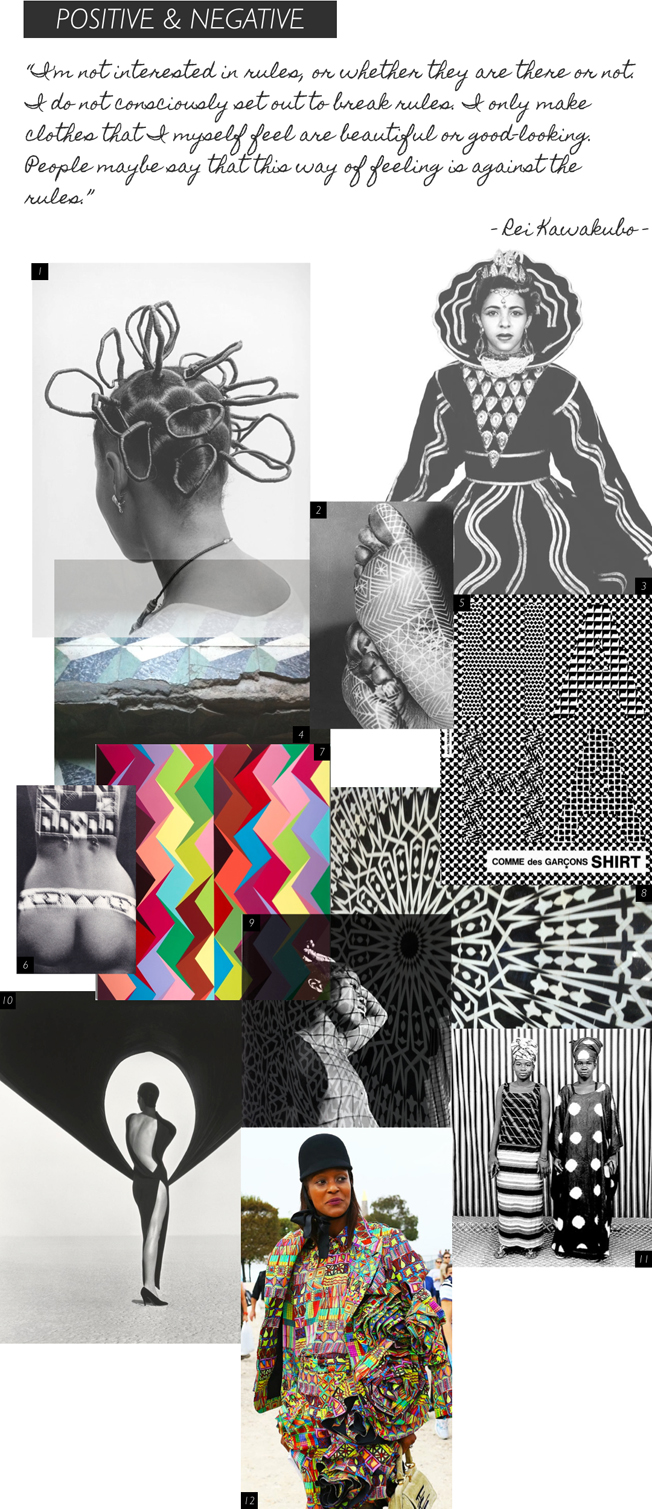‘I’m not interested in rules, or whether they are there or not. I do not consciously set out to break rules. I only make clothes that I myself feel are beautiful or good-looking. People maybe say that this way of feeling is against the rules.’
Rei Kawakubo
OUR RELATIONSHIP WITH DRESS and fashion – as individuals and as a cultural collective – is guided by the necessary rules and edicts that reinforce what we should, or more importantly, should not, wear. These form like the repeated lines of opposing graphics in a print or pattern that carefully divide one visual element from another, separating positive and negative values in space. In this instalment to our collaborative series with Missla Libsekal of Another Africa, we look at the way graphics are visually arranged, divided and drawn over the body, balancing these tensions of form and colour to impose a two-dimensional pattern on the body.
Aesthetic codes of dress are omnipresent throughout fashion media and communication. From the point of sale, to the images and text of magazines and press, we are rigorously and consistently told ‘what to wear’ and ‘what not to wear’ with a decisiveness that filters into every aspect of clothing. Particular modes of dress are either ‘good’ or ‘bad’, ‘positive’ or ‘negative’ binary opposites that form repeated patterns of behaviour in a network of rules weighted with consequence. Print and pattern in dress is itself an aesthetic dictated by such rules: how one should wear printed fabric, supposedly to avoid ‘clashing’ or ‘gaudiness’, is a familiar seasonal dialogue.
Rei Kawakubo’s statement that in designing she is ‘not interested in rules, or whether they are there or not’ is somewhat significant in this respect, but perhaps idealistic when looking at the output of Comme des Garçons. More often than not, the designer’s work is inextricably linked with the cultural and societal dictums of style that it is exposed to. In other words engaging with sartorial norms is unavoidable. Even so, it seems the further a designer places their work away from such codes, the more they are subject to comparison with them. The infamous, and affectionately titled ‘Lumps and Bumps’ collection did just this in its outlandish rejection of the ‘ideal’ figure. These notions weave through every aspect of the Comme des Garçons’ sensibility and we see a similar rejection of what is aesthetically pleasing in the graphics of the Comme des Garçons Shirt advertisement artwork by Tauba Auerbach, something that is frustrating to observe in its optical dynamic. Likewise, the accessories designer, Michelle Elie embodies these apparent tensions in her highly graphic ensemble at Paris Fashion Week, rejecting style commandments of balance and restraint. The Comme des Garçons outfit that she wears is layered to a clashing and noisy effect, going against how print is generally expected to be worn; that is, with balance and subtlety.
The Nigerian photographer J.D. ‘Okhai Ojeikere’s iconic images of the hairstyles of his native culture, show painstakingly crafted forms on the head. The graphic effect of creating positive and negative space with hair is a powerful stylistic example of the balance of print on the body. Not unlike the function of print, the surface of the skull is subject to the dividing characteristics of pattern. Similarly, the hennaed feet in the adjacent image by Malian photographer Alioune Bâ, ‘Djabi’, show a traditional and culturally symbolic technique that is used to created graphic boundaries on the body.
Throughout these images, there is a notion of balance through the use of pattern on the body: creating an equilibrium between positive and negative values. Herb Ritts’ photograph ‘El Mirage’ from 1990, captures the seductive power of this tension between spaces. Through shadow, the feminine curvature of the body is enhanced with the photographer’s signature stylistic execution. Next to this, Constance Stuart Larrabee’s black and white image of a boy under the shadows of mesh window frame, also reflects an application of print – albeit less stylistically that Ritts – to create form and balance on the natural landscape of the body.
Pattern and print could thus be a metaphor, or visual realisation of these omnipresent guidelines that reside over fashion and the way we dress from day to day. Both deal with necessary opposites in order to create balance (or lack of), trading in positive and negative values, from what we should or should not wear on our bodies, to the tensions created from opposing forms or hues on a colour wheel.
- J.D. ‘Okhai Ojeikere, ‘Untitled’, 2006
- Alioune Bâ, ‘Djabi’, 1997. Courtesy of Opus Art
- Valérie Belin, ‘Moroccan Brides (Untitled)’, 2000
- Floor tiles at Palais Mokri, Fez, Morocco
- Comme des Garçons Shirt artwork by Tauba Auerbach, 2008
- Untitled (Ndebele woman), copyright Sam Haskins, from the book ‘African Image’
- Odili Donald Odita, ‘Sister Midnight’, 2013
- Moroccan zelig tiles, in Fez, Morocco
- Constance Stuart Larrabee’s image of a young gold miner watching Sunday mine dance, Witwatersrand, near Johannesburg, 1948. Courtesy of the National Museum of African Art
- Herb Ritts, ‘El Mirage’, 1990, showing the back view of a Versace dress
- Malick Sidibé, ‘Les 2 Amies (Cousins)’, 1975
- Michelle Elie wearing Comme des Garçons during Paris Fashion Week
Missla Libsekal is the founding editor of Another Africa.
